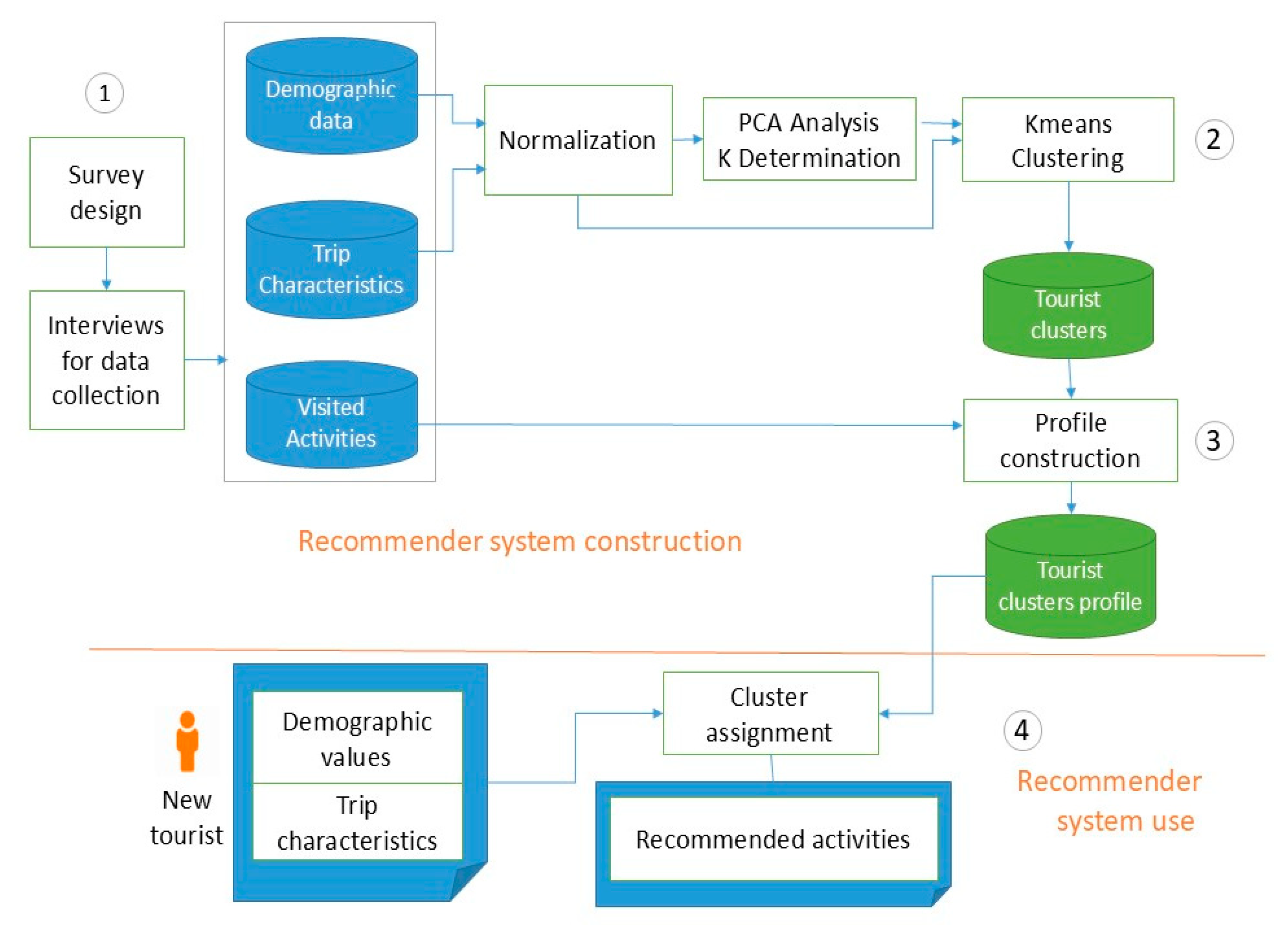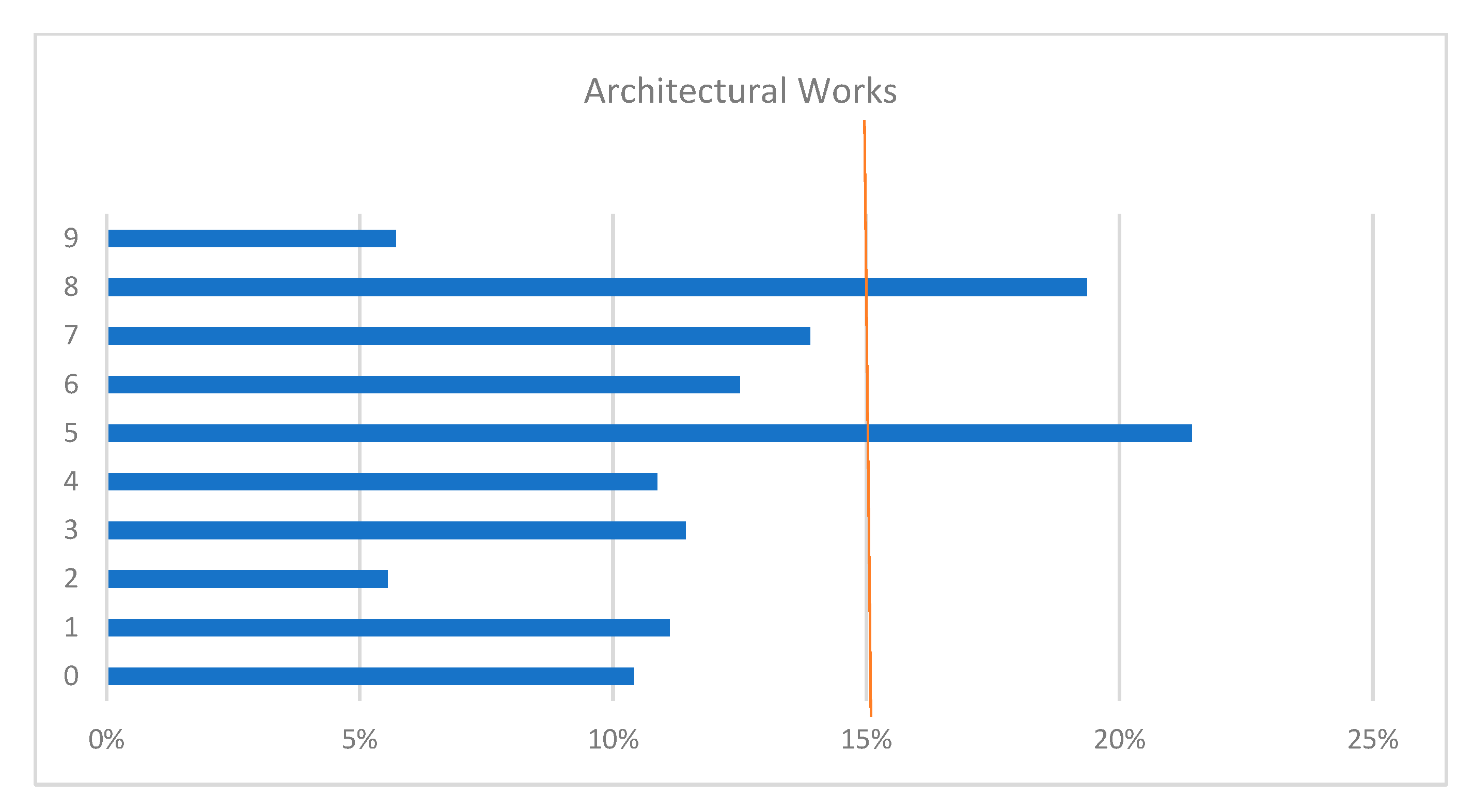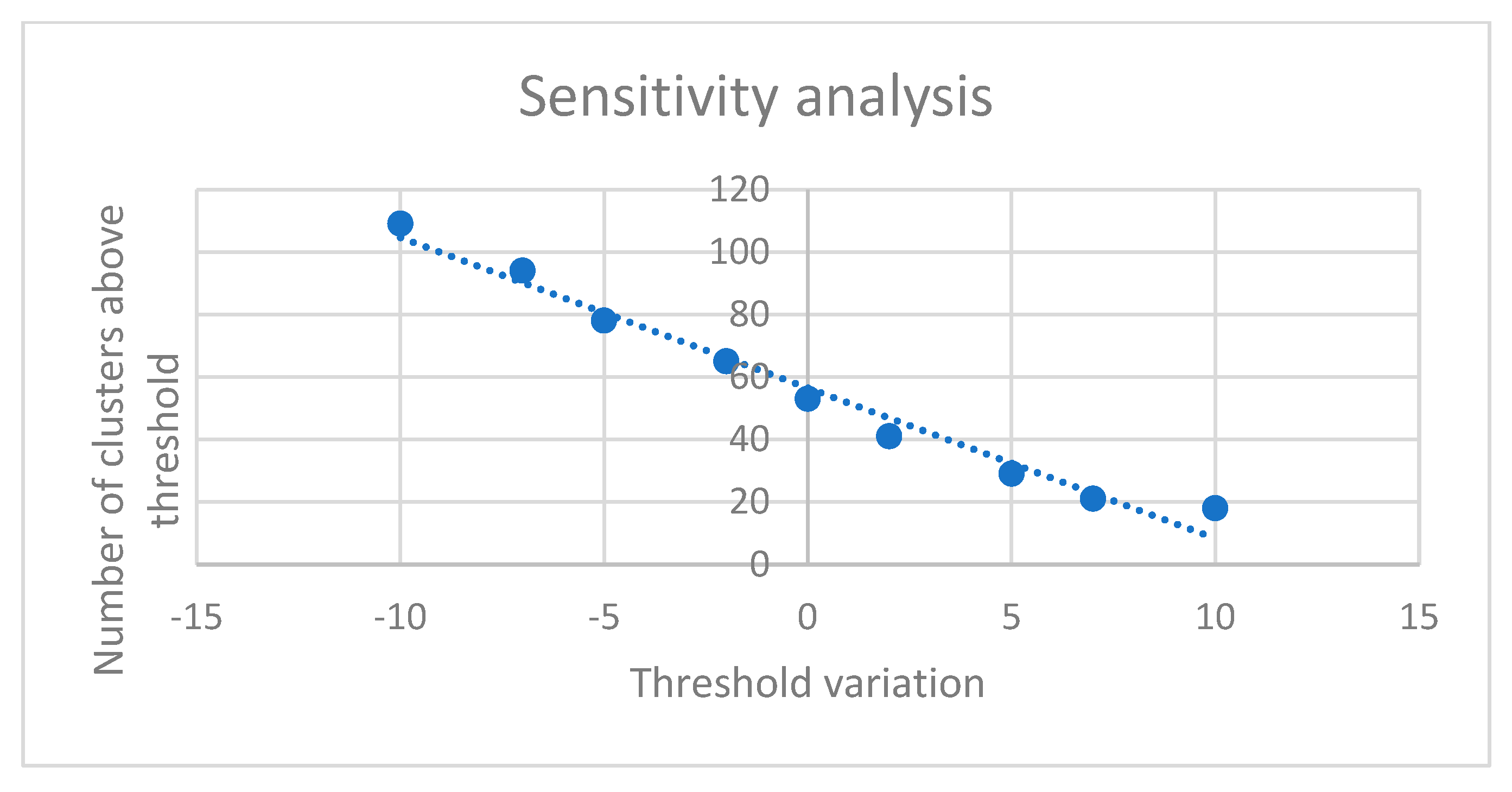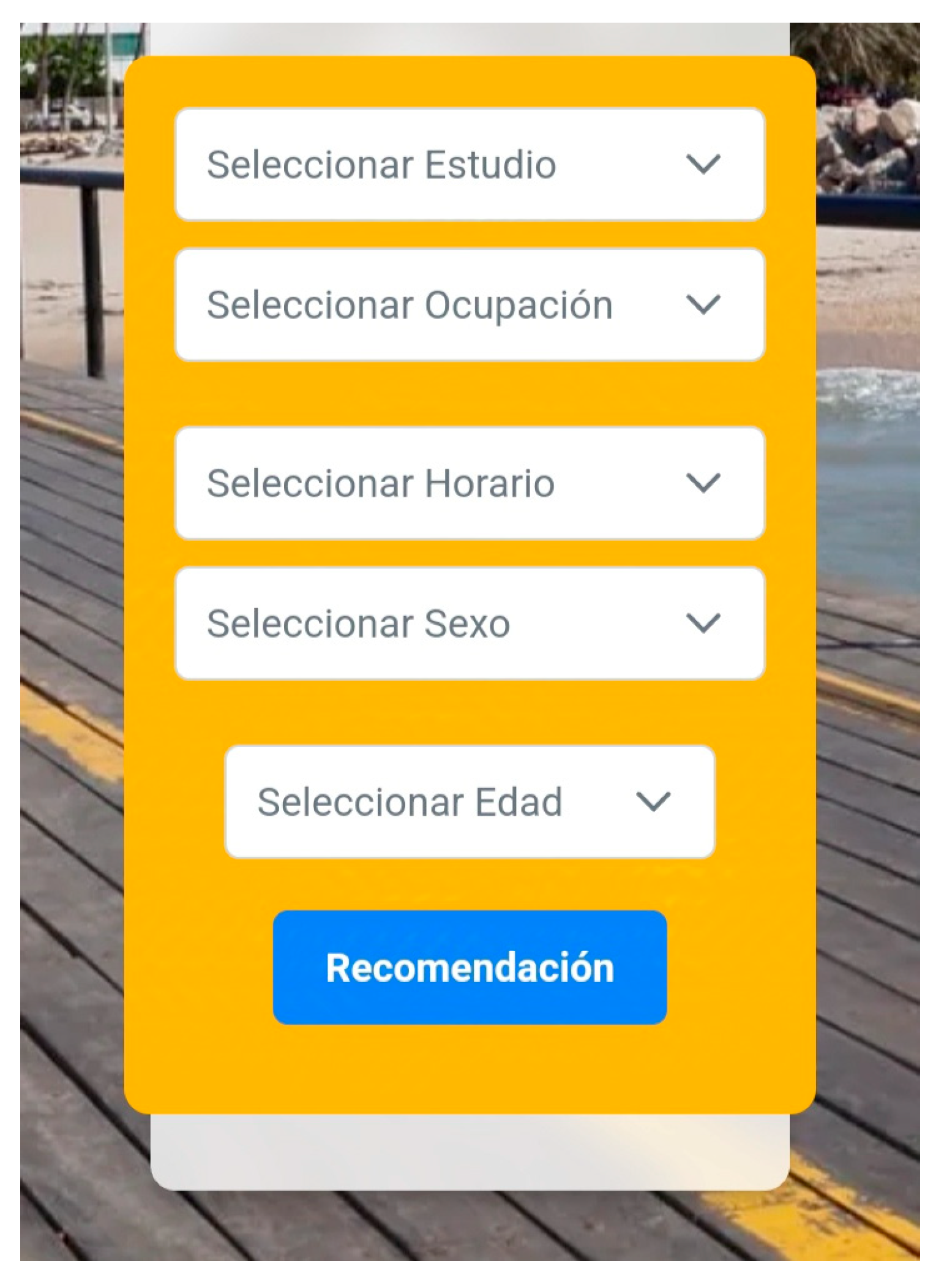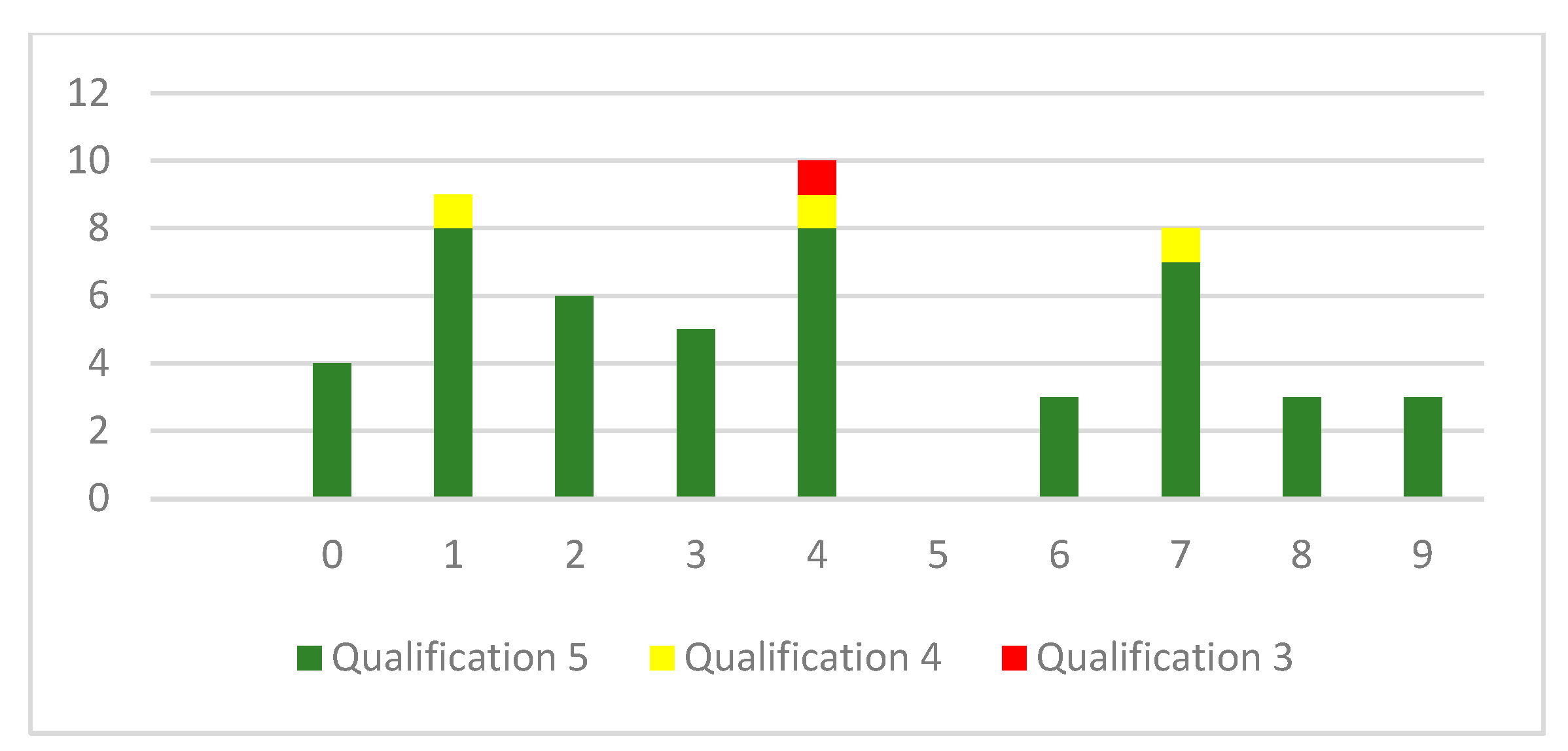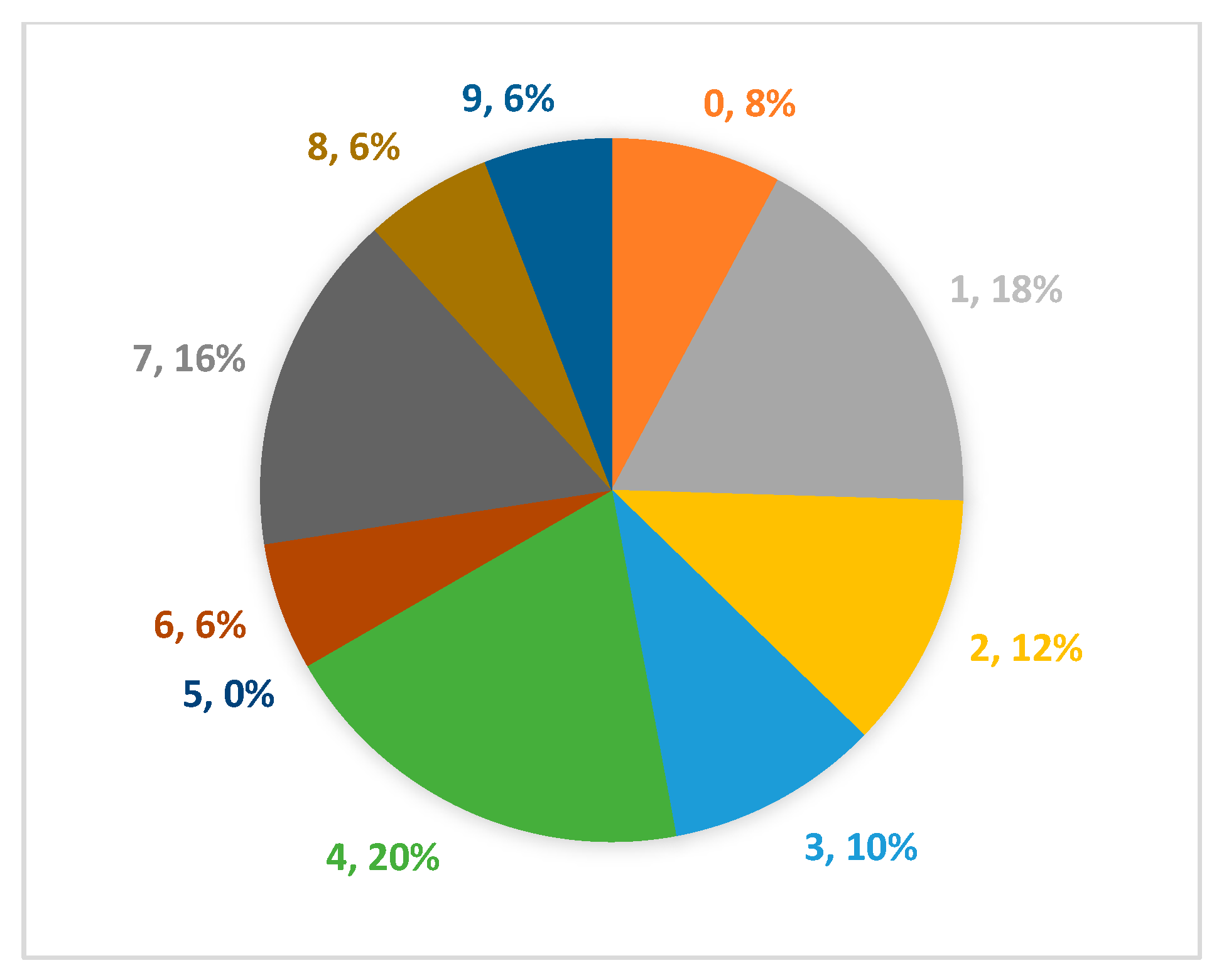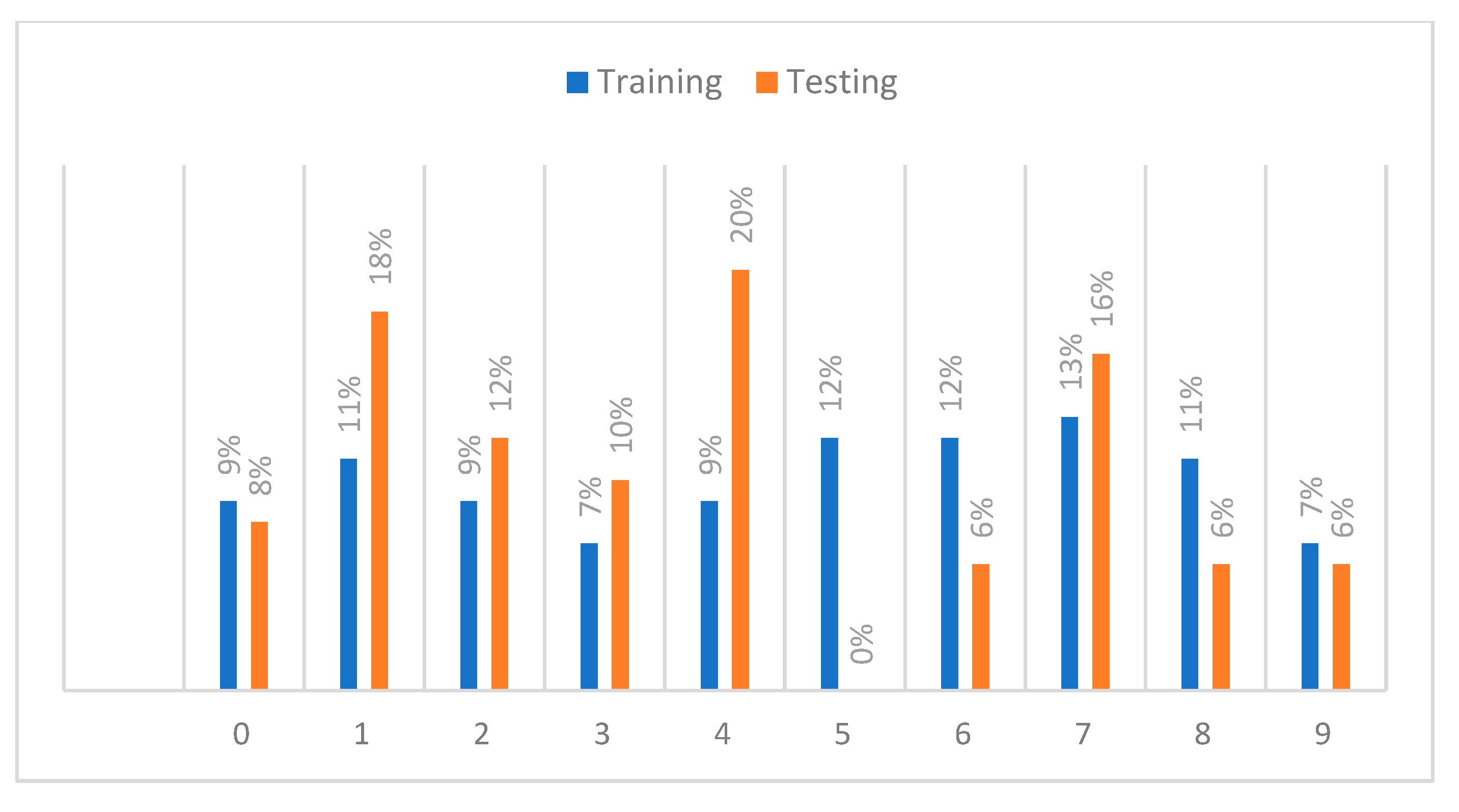5. Conclusions
The proposed recommender system uses machine learning techniques, such as the K-means algorithm, to segment tourists according to sociodemographic data and travel preferences, and an OWA operator with a disjunctive policy that assigns the most relevant cluster to each of them. An algorithm for determining the most relevant activities in each cluster has been presented. This is a new content-based recommendation procedure that allows the provision of personalized recommendations in touristic destinations based on the observation of other travelers’ features and behavior.
The flexible profile-based recommendation system shows great potential for promoting cultural tourism in emerging destinations. This paper has addressed the case of Riohacha (Colombia), with the aim to improve the visitor experience in the historic center of this beautiful city. The constructed recommender system not only increases the visibility of local attractions, but also permits the identification of distinctive tourist profiles, which may be of interest to the local destination tourism managers. It is worth mentioning that for emerging destinations, where tourism has not yet been studied, the method proposed needs only the collection of a representative visitor’s data by means of a survey. The artificial intelligence techniques used for the exploitation of this data and recommendation generation are fast and of low computational cost, which is a great advantage in comparison with other approaches based on huge deep learning or language models.
The evaluation and validation process of the recommendation system showed a high level of satisfaction in terms of ease of use and effectiveness of recommendations. Satisfaction rates reached 100% in several aspects, such as ease of navigation, relevance of content, effectiveness of information provided, and recommending the application to other users. In addition, users expressed interest in extending the recommendations to include local gastronomic and cultural experiences beyond the immediate area.
The proposal not only effectively addresses the particularities of the context but also establishes a replicable approach for regions with similar cultural and tourism characteristics. The methodology and techniques developed in this study can be adapted globally, allowing for the optimization of the visitor experience and the enhancement of cultural heritage.
The main limitations of the study are related to the lack of available and updated data for the construction of the recommender system, a common situation in emerging tourism destinations, especially due to the absence of historical data. Therefore, it is not possible to apply content-based techniques which require having previous evaluations of the different features of the items, nor collaborative techniques that need to exploit the information of the scores given by other users. In addition, it is not possible to have quantitative metrics (e.g., precision, recall, F1 score), because these metrics require information based on users’ actual behavior in response to the recommendations. The current prototype does not permit collecting these data at the moment, but we plan to work on that in order to be able to analyze usage logs for a quantitative evaluation. Moreover, in future work, we should study the possibility of including a broader and more diverse set of features related to trip characteristics, such as length of stay and level of expenditure. It is also planned to extend the demographic descriptors to achieve a more detailed characterization of tourist profiles. These improvements are intended to increase the adaptability and accuracy of the system in dynamic and heterogeneous tourism contexts, favoring a more effective personalization of recommendations.
A direct comparison of the proposed system with other recommenders is not feasible. Being an emerging tourist destination, Riohacha does not have a detailed textual description of each specific point of interest (that is why the recommendation was focused on types of activities, rather than on concrete items); thus, content-based semantic recommenders or recommenders based on embeddings generated from textual content are not applicable. Moreover, the lack of a strong tourism industry makes it impossible to obtain a large number of opinions and ratings from traditional worldwide touristic platforms like Tripadvisor, preventing the use of content filtering techniques. They could be applicable in the future, when the system is deployed and enough ratings and opinions have been obtained.
Author Contributions
Conceptualization, I.A.-J., A.S.-B., A.V., A.M. and M.C.-P.; methodology, I.A.-J., A.S.-B., A.V. and A.M.; software, I.A.-J., A.S.-B. and M.A.-C.; validation, J.E.-G. and M.A.-C.; formal analysis, I.A.-J., A.S.-B., A.V., A.M. and J.E.-G.; investigation, I.A.-J., A.S.-B., A.V., A.M. and M.C.-P. resources, J.E.-G. and M.A.-C.; data curation, A.V., A.M., J.E.-G. and M.A.-C.; writing—original draft preparation, I.A.-J. and A.S.-B.; writing—review and editing, A.V., A.M., M.C.-P., J.E.-G. and M.A.-C.; visualization, I.A.-J.; supervision, J.E.-G. and M.A.-C.; project administration, J.E.-G.; funding acquisition, J.E.-G. All authors have read and agreed to the published version of the manuscript.
Funding
Universitat Rovira i Virgili with project 2023PFR-URV-00114; Departament de Recerca i Universitats of Generalitat de Catalunya (Consolidated research group 2021 SGR 00114); the Spanish network ELIGE-IA on recommender systems; Universidad de la Guajira-Colombia and Minciencias Colombia (Bicentenary PhD grant).
Institutional Review Board Statement
This study was non-interventional in nature and based on an anonymous survey; therefore, it did not require ethical approval from an institutional review board. Data collection was conducted in accordance with current Colombian regulations on personal data protection, specifically Law 1581 of 2012 and Decree 1377 of 2013, which govern the handling of sensitive information and ensure the anonymity of participants.
Informed Consent Statement
Verbal informed consent was obtained from the participants. Verbal consent was obtained rather than written because participants were randomly selected tourists who voluntarily agreed to respond to the survey, and due to the non-sensitive nature of the questions, written consent was not deemed necessary. All procedures were conducted in accordance with ethical standards and in compliance with the Colombian data protection regulations, specifically Law 1581 of 2012 and its regulatory decrees, which safeguard the rights of individuals regarding the collection and processing of personal data.
Data Availability Statement
Conflicts of Interest
The authors declare no conflict of interest.
References
- Moreno, A.; Valls, A.; Isern, D.; Marin, L.; Borràs, J. SigTur/E-Destination: Ontology-based personalized recommendation of Tourism and Leisure Activities. Eng. Appl. Artif. Intell. 2013, 26, 633–651. [Google Scholar] [CrossRef]
- Halder, S.; Lim, K.H.; Chan, J.; Zhang, X. A survey on personalized itinerary recommendation: From optimisation to deep learning. Appl. Soft Comput. 2023, 152, 111200. [Google Scholar] [CrossRef]
- Pavlidis, G. Apollo—A Hybrid Recommender for Museums and Cultural Tourism. In Proceedings of the 2018 International Conference on Intelligent Systems (IS), Funchal, Portugal, 25–27 September 2018; pp. 94–101. [Google Scholar] [CrossRef]
- Ding, L. Research on Application System of Computer Artificial Intelligence Technology in Content Recommendation of Cultural Tourism Industry in Jilin Province. In Proceedings of the 2024 2nd International Conference on Mechatronics, IoT and Industrial Informatics (ICMIII), Melbourne, Australia, 12–14 June 2024; pp. 772–776. [Google Scholar] [CrossRef]
- Ministerio de Comercio, Industria y Turismo. Política de Turismo Cultural: Colombia, Destino Turístico Cultural, Creativo y Sostenible; Gobierno de Colombia: Bogotá, Colombia, 2021. [Google Scholar]
- Wu, Y.C.; Lin, S.W. Efficiency evaluation of Asia’s cultural tourism using a dynamic DEA approach. Socio-Econ. Plan. Sci. 2022, 84, 101426. [Google Scholar] [CrossRef]
- Nuanmeesri, S. Development of community tourism enhancement in emerging cities using gamification and adaptive tourism recommendation. J. King Saud Univ.-Comput. Inf. Sci. 2022, 34, 8549–8563. [Google Scholar] [CrossRef]
- El Congreso de Colombia. Plan Nacional De Desarrollo 2022–2026; Departamento Nacional de Planeación (DNP): Bogotá, Colombia, 2022. [Google Scholar]
- Bravo, J.; Alarcón, R.; Valdivia, C.; Serquén, O. Application of Machine Learning Techniques to Predict Visitors to the Tourist Attractions of the Moche Route in Peru. Sustainability 2023, 15, 8967. [Google Scholar] [CrossRef]
- Lou, N. Tourism Destination Recommendation Based on Association Rule Algorithm. Mob. Inf. Syst. 2022, 2022, 9331178. [Google Scholar] [CrossRef]
- Karthiyayini, J.; Anandhi, R.J. To Analyze the Various Machine Learning Algorithms That Can Effectively Process Large Volumes of Data and Extract Relevant Information for Personalized Travel Recommendations. SN Comput. Sci. 2024, 5, 336. [Google Scholar] [CrossRef]
- Huda, C.; Heryadi, Y.; Lukas; Budiharto, W. A tourism dataset from historical transaction for recommender systems. Data Brief 2024, 52, 109990. [Google Scholar] [CrossRef]
- Aldayel, M.; Al-Nafjan, A.; Al-Nuwaiser, W.M.; Alrehaili, G.; Alyahya, G. Collaborative Filtering-Based Recommendation Systems for Touristic Businesses, Attractions, and Destinations. Electronics 2023, 12, 4047. [Google Scholar] [CrossRef]
- Solano-Barliza, A.; Valls, A.; Moreno, A.; Dujmovic, J.; Acosta-Coll, M.; Escorcia-Gutierrez, J.; De-La-Hoz-Franco, E. Personalized Hotel Recommender System Based on Graded Logic Personalized Hotel Recommender System Based on Graded Logic with Asymmetric Criteria with Asymmetric Criteria. Procedia Comput. Sci. 2024, 246, 2864–2873. [Google Scholar] [CrossRef]
- Badouch, M.; Boutaounte, M. Personalized Travel Recommendation Systems: A Study of Machine Learning Approaches in Tourism. J. Artif. Intell. Mach. Learn. Neural Netw. 2023, 33, 35–45. [Google Scholar] [CrossRef]
- Solano-Barliza, A.; Arregocés-Julio, I.; Aarón-Gonzalvez, M.; Zamora-Musa, R.; De-La-Hoz-Franco, E.; Escorcia-Gutierrez, J.; Acosta-Coll, M. Recommender systems applied to the tourism industry: A literature review. Cogent Bus. Manag. 2024, 11, 2367088. [Google Scholar] [CrossRef]
- Pandey, P.; Mayank, K.; Sharma, S. Recommendation System for Adventure Tourism. In Proceedings of the 2023 4th IEEE Global Conference for Advancement in Technology, Bangalore, India, 6–8 October 2023; pp. 1–7. [Google Scholar] [CrossRef]
- Pandya, S.; Shah, J.; Joshi, N.; Ghayvat, H.; Mukhopadhyay, S.C.; Yap, M.H. A novel hybrid based recommendation system based on clustering and association mining. In Proceedings of the 2016 10th International Conference on Sensing Technology (ICST), Nanjing, China, 11–13 November 2016; pp. 1–6. [Google Scholar] [CrossRef]
- Lemma, T.; Byrne, W.; Tadisetti, S. A Hybrid Machine Learning Enabled Tourism Recommender System Providing a Context-Aware Experience to Tourists in Ireland. In Proceedings of the 2023 1st International Conference on Advanced Engineering and Technologies (ICONNIC), Kediri, Indonesia, 13–14 October 2023; pp. 275–280. [Google Scholar] [CrossRef]
- Carvache-Franco, M.; Hassan, T.; Carvache-Franco, O.; Carvache-Franco, W.; Martin-Moreno, O. Demand segmentation and sociodemographic aspects of food festivals: A study in Bahrain. PLoS ONE 2023, 18, 0287113. [Google Scholar] [CrossRef]
- Marques, C.; da Silva, R.V.; Antova, S. Image, satisfaction, destination and product post-visit behaviours: How do they relate in emerging destinations? Tour. Manag. 2021, 85, 104293. [Google Scholar] [CrossRef]
- Konstantakis, M.; Alexandridis, G.; Caridakis, G. A personalized heritage-oriented recommender system based on extended cultural tourist typologies. Big Data Cogn. Comput. 2020, 4, 12. [Google Scholar] [CrossRef]
- Chang, A.Y.P.; Hung, K.P. Development and validation of a tourist experience scale for cultural and creative industries parks. J. Destin. Mark. Manag. 2021, 20, 100560. [Google Scholar] [CrossRef]
- Lenis Escobar, A.; Rueda López, R.; Pérez-Priego, M.; García-Moreno García, M.D.L.B. Perception, motivation, and satisfaction of female tourists with their visit to the city of Cordoba (Spain). Sustainability 2020, 12, 7595. [Google Scholar] [CrossRef]
- DANE. Clasificación Industrial Internacional Uniforme de todas las actividades económicas. Versión 4 adaptada para Colombia. Angew. Chemie Int. Ed. 2021, 119, 361–416. [Google Scholar]
- Sevilla Villanueva, B. A Methodology for Pre-Post Intervention Studies: An Application for a Nutritional Case Study. Available online: https://widgets.ebscohost.com/prod/customerspecific/ns000545/customproxy.php?url=https://search.ebscohost.com/login.aspx?direct=true&db=edstdx&AN=edstdx.10803.392610&%0Alang=pt-pt&site=eds-live&scope=site (accessed on 1 June 2020).
- Ezugwu, A.E.; Ikotun, A.M.; Oyelade, O.O.; Abualigah, L.; Agushaka, J.O.; Eke, C.I.; Akinyelu, A.A. A comprehensive survey of clustering algorithms: State-of-the-art machine learning applications, taxonomy, challenges, and future research prospects. Eng. Appl. Artif. Intell. 2022, 110, 104743. [Google Scholar] [CrossRef]
- Musthafa, N.; Raji, C.G. Hybrid Recommender System using K-means Clustering. In Proceedings of the 2022 8th International Conference on Advanced Computing and Communication Systems (ICACCS), Coimbatore, India, 25–26 March 2022; pp. 625–630. [Google Scholar] [CrossRef]
- Kumar, M.R.; Vishnu, S.; Roshen, G.; Kumar, D.N.; Revathi, P.; Baster, D.R.L. Product Recommendation Using Collaborative Filtering and K-Means Clustering. In Proceedings of the 2024 IEEE International Conference on Computing, Power and Communication Technologies (IC2PCT), Greater Noida, India, 9–10 February 2024; pp. 1722–1728. [Google Scholar] [CrossRef]
- Zacarias, H.; Cangondo, G.; Souza-Pereira, L.; Garcia, N.M.; Silva, B.; Pombo, N. Application of Content-Base Recommendation Algorithms on Mobile Travel Applications. In Proceedings of the 2023 1st International Conference on Advanced Innovations in Smart Cities (ICAISC), Jeddah, Saudi Arabia, 23–25 January 2023; pp. 1–5. [Google Scholar] [CrossRef]
- Ojeda-Beltrán, A.; Solano-Barliza, A.; Arrubla-Hoyos, W.; Ortega, D.D.; Cama-Pinto, D.; Holgado-Terriza, J.A.; Damas, M.; Toscano-Vanegas, G.; Cama-Pinto, A. Characterisation of Youth Entrepreneurship in Medellín-Colombia Using Machine Learning. Sustainability 2023, 15, 10297. [Google Scholar] [CrossRef]
- Cazals, F. A mini-review of clustering algorithms and their theoretical properties, with applications to molecular science. J. Innov. Mater. Extrem. Cond. 2024, 5. Available online: https://inria.hal.science/hal-04504440v1 (accessed on 20 January 2025).
- Arbelaitz, O.; Gurrutxaga, I.; Muguerza, J.; Pérez, J.M.; Perona, I. An extensive comparative study of cluster validity indices. Pattern Recognit. 2013, 46, 243–256. [Google Scholar] [CrossRef]
- Van Mechelen, I.; Boulesteix, A.; Dangl, R.; Dean, N.; Hennig, C.; Leisch, F.; Steinley, D.; Warrens, M.J. A white paper on good research practices in benchmarking: The case of cluster analysis. Wiley Interdiscip. Rev. Data Min. Knowl. Discov. 2023, 13, 1511. [Google Scholar] [CrossRef]
- Rodriguez, M.Z.; Comin, C.H.; Casanova, D.; Bruno, O.M.; Amancio, D.R.; Costa, L.D.F.; Rodrigues, F.A. Clustering algorithms: A comparative approach. PLoS ONE 2019, 14, e0210236. [Google Scholar] [CrossRef]
- Davies, D.L.; Bouldin, D.W. A Cluster Separation Measure. IEEE Trans. Pattern Anal. Mach. Intell. 1979, PAMI-1, 224–227. [Google Scholar] [CrossRef]
- Thomas, J.C.R.; Peñas, M.S.; Mora, M. New Version of Davies-Bouldin Index for Clustering Validation Based on Cylindrical Distance. In Proceedings of the 2013 32nd International Conference of the Chilean Computer Science Society (SCCC), Temuco, Chile, 11–15 November 2013; pp. 49–53. [Google Scholar] [CrossRef]
- Yager, R.R. Quantifier guided aggregation using OWA operators. Int. J. Intell. Systems 1996, 11, 49–73. [Google Scholar] [CrossRef]
| Disclaimer/Publisher’s Note: The statements, opinions and data contained in all publications are solely those of the individual author(s) and contributor(s) and not of MDPI and/or the editor(s). MDPI and/or the editor(s) disclaim responsibility for any injury to people or property resulting from any ideas, methods, instructions or products referred to in the content. |
© 2025 by the authors. Licensee MDPI, Basel, Switzerland. This article is an open access article distributed under the terms and conditions of the Creative Commons Attribution (CC BY) license (https://creativecommons.org/licenses/by/4.0/).
